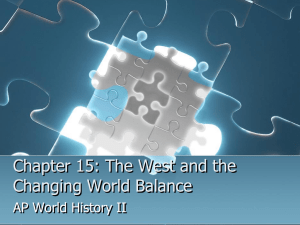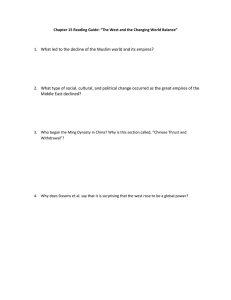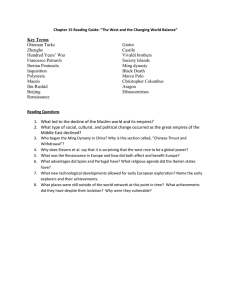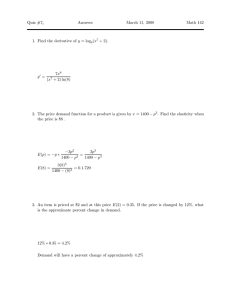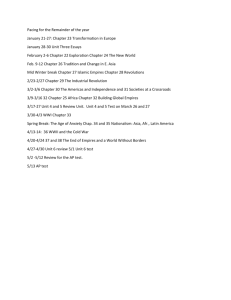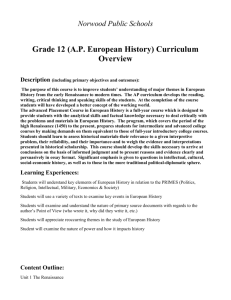Chapter 15: The West and the Changing World Balance Key Concepts…
advertisement
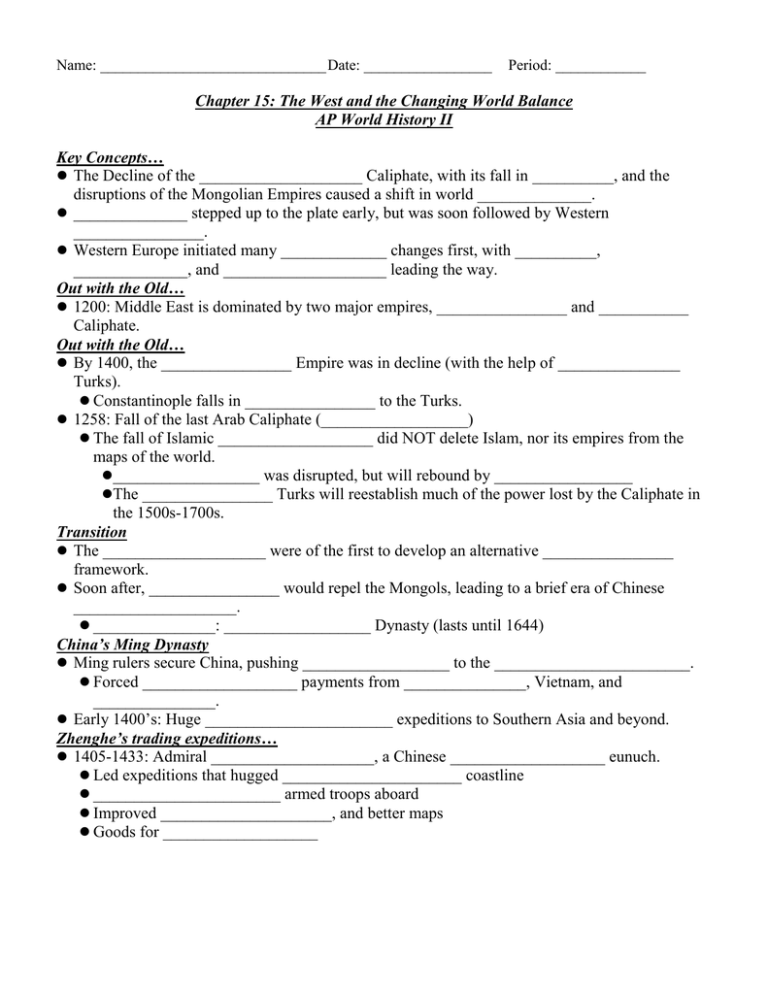
Name: ______________________________ Date: _________________ Period: ____________ Chapter 15: The West and the Changing World Balance AP World History II Key Concepts… The Decline of the ____________________ Caliphate, with its fall in __________, and the disruptions of the Mongolian Empires caused a shift in world ______________. ______________ stepped up to the plate early, but was soon followed by Western ________________. Western Europe initiated many _____________ changes first, with __________, ______________, and ____________________ leading the way. Out with the Old… 1200: Middle East is dominated by two major empires, ________________ and ___________ Caliphate. Out with the Old… By 1400, the ________________ Empire was in decline (with the help of _______________ Turks). Constantinople falls in ________________ to the Turks. 1258: Fall of the last Arab Caliphate (__________________) The fall of Islamic ___________________ did NOT delete Islam, nor its empires from the maps of the world. __________________ was disrupted, but will rebound by _________________ The ________________ Turks will reestablish much of the power lost by the Caliphate in the 1500s-1700s. Transition The ____________________ were of the first to develop an alternative ________________ framework. Soon after, ________________ would repel the Mongols, leading to a brief era of Chinese ____________________. _______________: __________________ Dynasty (lasts until 1644) China’s Ming Dynasty Ming rulers secure China, pushing __________________ to the ________________________. Forced ___________________ payments from _______________, Vietnam, and _______________. Early 1400’s: Huge _______________________ expeditions to Southern Asia and beyond. Zhenghe’s trading expeditions… 1405-1433: Admiral ____________________, a Chinese ___________________ eunuch. Led expeditions that hugged ______________________ coastline _______________________ armed troops aboard Improved _____________________, and better maps Goods for ___________________ The end of Asian expansion Zhenghe’s expeditions were called off in ____________________. Resented by _______________________ bureaucracy Unacceptable __________________ (especially when fighting the Mongols, and building a new capital city in _________________________) Rooted in China’s history of emphasizing ___________________ development, keeping ___________________ development at bay. China squanders the opportunity, but _________________________ becomes stronger as a result. Rise of the West Where was the west around 1400? The __________________________ (dominant institution of the Middle Ages) was under attack. 1215: ________________ ________________________ Medieval ________________________…not so creative Warrior ___________________________…not as warrior-like By 1300, ______________________ outpaced food supply…causes _________________ No new food supply ______________________ were discovered. The Rise of the West The ________________ Plague (or, ____________________ Plague): Reduces Chinese population by _______________% by 1400. Follows trade routes from ________________ to the ___________________ East 1348-1375: Europe’s worst episode, killing ___________________ people, roughly _____ of Europe. The Rise of the West How did the West achieve dominance? Strengthening of Feudal _____________________________ ____________________ Years’ War (Britain and France) stimulated _______________ technology Central power of ________________________ increase Christians drove _____________________ out of Spain and Portugal Growth of cities spurs __________________ economies centered on commercial _______________. __________________________ continued to expand The Rise of the West How else, then, did the West achieve dominance? Mongol domination of Asia in the 13th and early 14th centuries opened up Asian technology to the Westerners. ___________________ _________________ ________________________ ________________________ Ever since the ________________, Europeans had a greater desire for Asian made goods, resulting in an _________________________ balance of trade, causing a Gold __________________ that threatened the European economy. The Rise of the West The rise of the Ottoman’s also led to increased fear over a __________________ surge in power. Search for new ways ___________________ the newly-developing Muslim Empire The Rise of the West 1400’s: Italy, cultural and political movement known as rebirth, or the ___________________ Stressed more ______________________ subjects Realistic portrayals of people and _____________________ Why Italy? Connection to Ancient ___________________ 14th Century: Led the West in _______________________ and trade Healthy commercial practices gave the money to be able to support ______________ activities. Renaissance Culture A Cultural Movement Practical ethics, urban codes of _____________________ Art and ___________________ flourish Themes include nature and ________________________ Architecture moves from _____________________ to _______________________ Impact of the Renaissance Little influence outside of ______________________ Focused on high culture, not ______________________- culture Minimal interest in _____________________ Not a FULL-break from _______________________ Although, Italian _____________________ proved to be a building block of European power. The “Renaissance _____________________________” spurred innovation. The Iberian Contribution Christian leaders had been pushing back ________________________ forces for years. After 1400 regional monarchies had been established in the provinces of _______________ and __________________-, united in Marriage in __________________. Ferdinand and Isabella Spanish and ___________________ formed a unified agenda for the expulsion of the Muslims, continued by the marriage of Ferdinand and Isabella Effective armies with _______________________- Government should promote _______________________ through conversion. Close links between ____________________ and State Western Expansion…attempt #1 Early ventures were inhibited by ______________________ barriers. Efforts were underway to improve these technologies through ______________ contacts, who learned from the ____________________. _______________________ improved 1498: Vasco de Gama was the first European to reach _______________________ by sea. Colonial Patterns Prince _____________________ of Portugal (Prince Henry the ______________________) was a driving force in making the colonies Spain and Portugal already had, ___________________. Student of ________________________ and Nautical Science Sponsored a third of Portuguese ventures before his death in __________________. Mixture of __________________, knowledge, money, and __________________ motivate him. Colonial Patterns Iberians set up a system of ___________________________ that would be seen for years to come. Colonists set up large ___________________ estates for _______________ crops to be sold on European market. Introduced ________________, then cotton and __________________ Used _______________________ labor from Northwest Africa Sound familiar? What’s going on elsewhere? Important note: Changes elsewhere are happening simultaneously, but unrelated to changes in Europe, Middle East, and Asia. Disunity in ________________________ Empires, and overextension throughout the 1400s caused weakened empires throughout the _________________________ What’s going on elsewhere? Polynesia: Expansion beyond the ______________________ Islands (Tahiti, Samoa, and Fiji). Migration to __________________, where Hawaiians and Polynesians mixed quickly. __________________ were imported to Hawaii Set up regional kingdom structure that was highly _____________________. Social ______________________ system dominated life Elsewhere… Maori’s migrate from Polynesia _____________________ to New Zealand. Successful adaptation to _______________________ environment. Tribal military leaders hold ___________________ ____________________ will be of the last places to be colonized by Europe later in history. Put it all together… Many changes, if not all, occur independently. Every change is explainable, but their combination is _____________________________. __________________________ Roles of _______________________ Impact of _____________________ shifts ________________________ movements Revolutions in ______________________________
